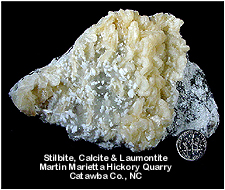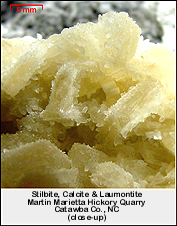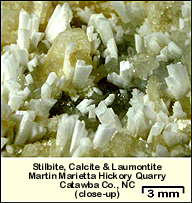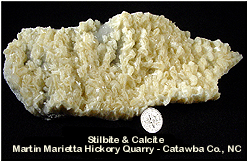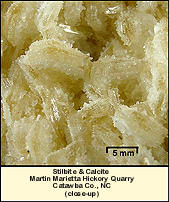Martin Marietta Hickory Quarry
Catawba County, North Carolina
January 21 & 28, 2006
By Mike Streeter
mcstreeter@charter.net
You have to get up early if you want to go to the Hickory quarry because the
only available collecting hours are from 7:00 AM until noon on Saturdays only. It is important to
note that prior arrangements must be made with the mine superintendent in order to collect at this
location. Trucks and other equipment are generally running throughout the quarry on Saturday
mornings, so great care must be taken to keep out of the way while collecting.
It was raining pretty hard when we showed up at 7:00 AM sharp, and it didn't appear
that it was going to stop anytime soon. But, it wasn't that rain that held us up, it was the sun
that was yet to rise. We hung around the mine office until around 7:30 when it was finally light
enough to head down into the quarry.
Since I knew that it was going to be a rainy day, I opted to leave my camera at
home and didn't take any site pictures in the quarry. However, I did manage to find an
aerial photograph on http://terraserver-usa.com that shows the quarry as it was in 1998. As you can see below, I
doctored the photograph to show local landmarks.
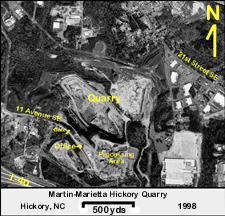
Click on above picture to enlarge
We found a relatively thin vein that contained some excellent pale-yellow
stilbite that was coated with a sparkling druse of what appears to be calcite along with
some white blades of laumontite. Although calcite and laumontite are known to occur in the
quarry, I had not seen them as druse on stilbite before, so I was quite pleased with this unusual
and beautiful find. We worked the thin vein to the extent feasible before it essentially pinched
off in all directions. I photographed a few of the more noteworthy specimens for your viewing
pleasure.
Click on each specimen picture to enlarge
Click on each specimen picture to enlarge
After we finished with the stilbite vein, David P., Ron and I roamed the quarry
looking for other opportunities. Knowing that we'd have to be out by noon, we tried to work at 1.5X
speed to make up for the short collecting window. Around mid-morning, we decided to see what Wayne,
David K. and Chrissy were up to as they had wandered off in their own direction and they had been way
too quiet. We found Wayne on one of the benches hammering away on a large boulder with a
sledgehammer. Although when we first pulled up it first appeared that boulder was winning the
battle, we noticed that Wayne was more than holding his own as he was surrounded by piles of smaller
rocks that had formerly been parts of boulders. Wayne showed us what was causing him to work so
hard - he had found the mother lode of babingtonite on the fracture surfaces of several large
boulders. Babingtonite is a relatively rare and small dark mineral that is often found associated
with zeolites. Wayne told us that babingtonite had been previously found at the quarry, but he had
NEVER seen this quantity of the mineral concentrated in one area before and said that it was unlikely
that we would ever see anything like this again. The babingtonite was mixed with massive prehnite.
Wayne was nice enough to point out some babingtonite boulders that Ron and I could reduce to
transport size. Before the day was over, EVERYONE would have enough babingtonite-covered rocks
to last a lifetime . . . or, at least, until the next time in the quarry.

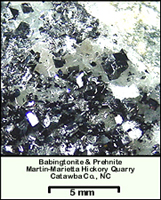
| |
Click on each specimen picture to enlarge
We managed to find a few more mineral specimens before time ran out.
Click on each specimen picture to enlarge
The noon whistle came way too quickly, as it usually seems to do in the Hickory
Quarry, and we quickly gathered our rocks and tools and made our way outside the main gate where we
stopped to clean up and talk rocks before hitting the road for home. We thanked Wayne for inviting us
and sharing his wealth of babingtonite! Thanks also goes to the mine superintendent, Larry Sherrill,
for continuing to allow rockhounds to access the quarry!
We returned to the quarry the following Saturday to go after few of the
minerals that needed rescue before they found their way the rock crusher. As you will see on the
next page, we managed to find some more mineral specimens.
Report continued . . . . . . .
Click Here for Next Page
